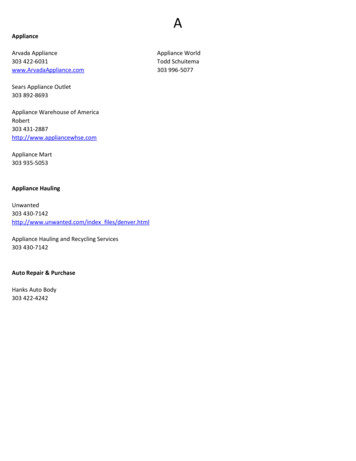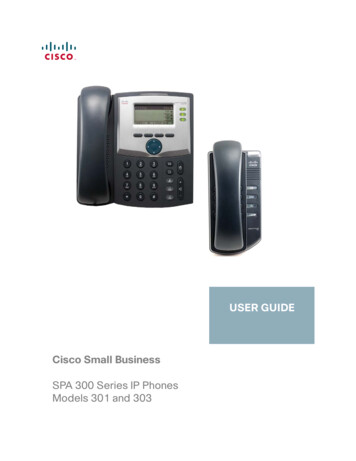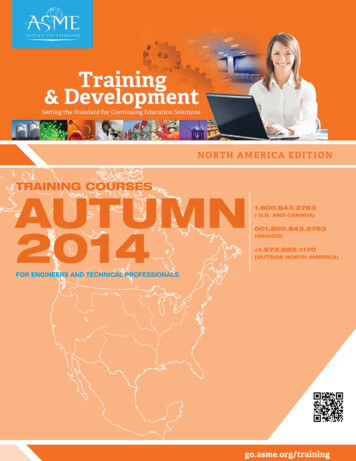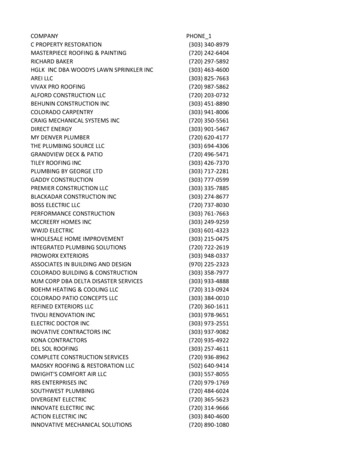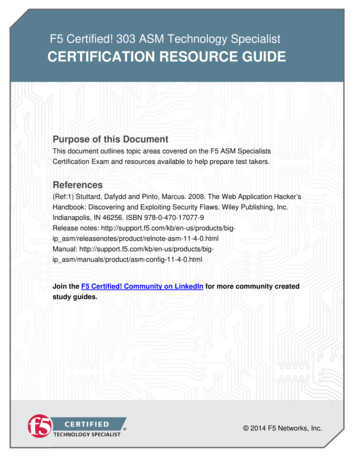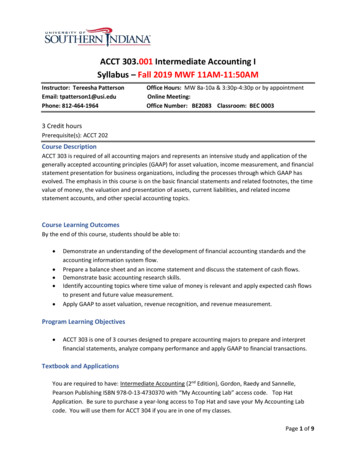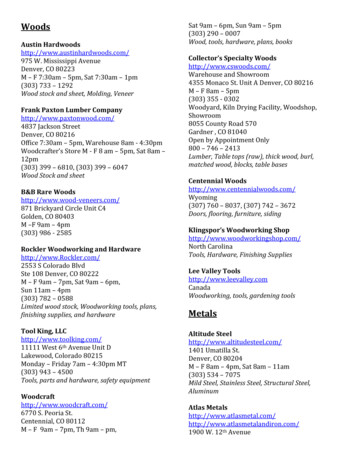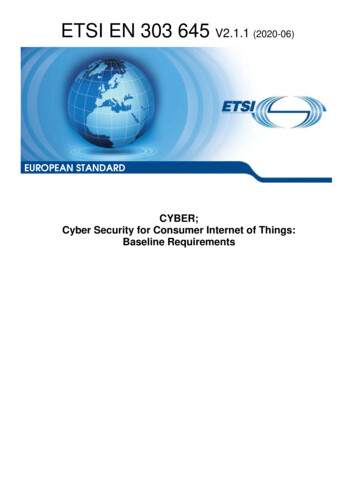
Transcription
ETSI EN 303 645 V2.1.1 (2020-06)EUROPEAN STANDARDCYBER;Cyber Security for Consumer Internet of Things:Baseline Requirements
2ETSI EN 303 645 V2.1.1 ity, IoT, privacyETSI650 Route des LuciolesF-06921 Sophia Antipolis Cedex - FRANCETel.: 33 4 92 94 42 00 Fax: 33 4 93 65 47 16Siret N 348 623 562 00017 - NAF 742 CAssociation à but non lucratif enregistrée à laSous-Préfecture de Grasse (06) N 7803/88Important noticeThe present document can be downloaded from:http://www.etsi.org/standards-searchThe present document may be made available in electronic versions and/or in print. The content of any electronic and/orprint versions of the present document shall not be modified without the prior written authorization of ETSI. In case of anyexisting or perceived difference in contents between such versions and/or in print, the prevailing version of an ETSIdeliverable is the one made publicly available in PDF format at www.etsi.org/deliver.Users of the present document should be aware that the document may be subject to revision or change of status.Information on the current status of this and other ETSI documents is available .aspxIf you find errors in the present document, please send your comment to one of the following pportStaff.aspxCopyright NotificationNo part may be reproduced or utilized in any form or by any means, electronic or mechanical, including photocopyingand microfilm except as authorized by written permission of ETSI.The content of the PDF version shall not be modified without the written authorization of ETSI.The copyright and the foregoing restriction extend to reproduction in all media. ETSI 2020.All rights reserved.DECT , PLUGTESTS , UMTS and the ETSI logo are trademarks of ETSI registered for the benefit of its Members.3GPP and LTE are trademarks of ETSI registered for the benefit of its Members andof the 3GPP Organizational Partners.oneM2M logo is a trademark of ETSI registered for the benefit of its Members andof the oneM2M Partners.GSM and the GSM logo are trademarks registered and owned by the GSM Association.ETSI
3ETSI EN 303 645 V2.1.1 (2020-06)ContentsIntellectual Property Rights .4Foreword.4Modal verbs terminology.4Introduction .41Scope .62References .62.12.233.13.23.3Normative references . 6Informative references . 7Definition of terms, symbols and abbreviations .9Terms. 9Symbols . 11Abbreviations . 124Reporting implementation .125Cyber security provisions for consumer IoT .135.15.25.35.45.55.65.75.85.95.105.115.125.136No universal default passwords . 13Implement a means to manage reports of vulnerabilities . 14Keep software updated . 15Securely store sensitive security parameters . 18Communicate securely . 19Minimize exposed attack surfaces . 20Ensure software integrity. 21Ensure that personal data is secure . 22Make systems resilient to outages . 22Examine system telemetry data . 23Make it easy for users to delete user data . 23Make installation and maintenance of devices easy . 24Validate input data. 24Data protection provisions for consumer IoT .24Annex A (informative):Basic concepts and models .26A.1Architecture .26A.2Device states .28Annex B (informative):Implementation conformance statement pro forma .31History .34ETSI
4ETSI EN 303 645 V2.1.1 (2020-06)Intellectual Property RightsEssential patentsIPRs essential or potentially essential to normative deliverables may have been declared to ETSI. The informationpertaining to these essential IPRs, if any, is publicly available for ETSI members and non-members, and can be foundin ETSI SR 000 314: "Intellectual Property Rights (IPRs); Essential, or potentially Essential, IPRs notified to ETSI inrespect of ETSI standards", which is available from the ETSI Secretariat. Latest updates are available on the ETSI Webserver (https://ipr.etsi.org/).Pursuant to the ETSI IPR Policy, no investigation, including IPR searches, has been carried out by ETSI. No guaranteecan be given as to the existence of other IPRs not referenced in ETSI SR 000 314 (or the updates on the ETSI Webserver) which are, or may be, or may become, essential to the present document.TrademarksThe present document may include trademarks and/or tradenames which are asserted and/or registered by their owners.ETSI claims no ownership of these except for any which are indicated as being the property of ETSI, and conveys noright to use or reproduce any trademark and/or tradename. Mention of those trademarks in the present document doesnot constitute an endorsement by ETSI of products, services or organizations associated with those trademarks.ForewordThis European Standard (EN) has been produced by ETSI Technical Committee Cyber Security (CYBER).National transposition datesDate of adoption of this EN:19 June 2020Date of latest announcement of this EN (doa):30 September 2020Date of latest publication of new National Standardor endorsement of this EN (dop/e):31 March 2021Date of withdrawal of any conflicting National Standard (dow):31 March 2021Modal verbs terminologyIn the present document "shall", "shall not", "should", "should not", "may", "need not", "will", "will not", "can" and"cannot" are to be interpreted as described in clause 3.2 of the ETSI Drafting Rules (Verbal forms for the expression ofprovisions)."must" and "must not" are NOT allowed in ETSI deliverables except when used in direct citation.IntroductionAs more devices in the home connect to the Internet, the cyber security of the Internet of Things (IoT) becomes agrowing concern. People entrust their personal data to an increasing number of online devices and services. Productsand appliances that have traditionally been offline are now connected and need to be designed to withstand cyberthreats.The present document brings together widely considered good practice in security for Internet-connected consumerdevices in a set of high-level outcome-focused provisions. The objective of the present document is to support allparties involved in the development and manufacturing of consumer IoT with guidance on securing their products.ETSI
5ETSI EN 303 645 V2.1.1 (2020-06)The provisions are primarily outcome-focused, rather than prescriptive, giving organizations the flexibility to innovateand implement security solutions appropriate for their products.The present document is not intended to solve all security challenges associated with consumer IoT. It also does notfocus on protecting against attacks that are prolonged/sophisticated or that require sustained physical access to thedevice. Rather, the focus is on the technical controls and organizational policies that matter most in addressing the mostsignificant and widespread security shortcomings. Overall, a baseline level of security is considered; this is intended toprotect against elementary attacks on fundamental design weaknesses (such as the use of easily guessable passwords).The present document provides a set of baseline provisions applicable to all consumer IoT devices. It is intended to becomplemented by other standards defining more specific provisions and fully testable and/or verifiable requirements forspecific devices which, together with the present document, will facilitate the development of assurance schemes.Many consumer IoT devices and their associated services process and store personal data, the present document canhelp in ensuring that these are compliant with the General Data Protection Regulation (GDPR) [i.7]. Security by designis an important principle that is endorsed by the present document.ETSI TS 103 701 [i.19] provides guidance on how to assess and assure IoT products against provisions within thepresent document.The provisions in the present document have been developed following a review of published standards,recommendations and guidance on IoT security and privacy, including: ETSI TR 103 305-3 [i.1], ETSITR 103 309 [i.2], ENISA Baseline Security Recommendations [i.8], UK Department for Digital, Culture, Media andSport (DCMS) Secure by Design Report [i.9], IoT Security Foundation Compliance Framework [i.10], GSMA IoTSecurity Guidelines and Assessment [i.11], ETSI TR 103 533 [i.12], DIN SPEC 27072 [i.20] and OWASP Internet ofThings [i.23].NOTE:Mappings of the landscape of IoT security standards, recommendations and guidance are available inENISA Baseline Security Recommendations for IoT - Interactive Tool [i.15] and in Copper HorseMapping Security & Privacy in the Internet of Things [i.14].As consumer IoT products become increasingly secure, it is envisioned that future revisions of the present documentwill mandate provisions that are currently recommendations in the present document.ETSI
61ETSI EN 303 645 V2.1.1 (2020-06)ScopeThe present document specifies high-level security and data protection provisions for consumer IoT devices that areconnected to network infrastructure (such as the Internet or home network) and their interactions with associatedservices. The associated services are out of scope. A non-exhaustive list of examples of consumer IoT devices includes: connected children's toys and baby monitors; connected smoke detectors, door locks and window sensors; IoT gateways, base stations and hubs to which multiple devices connect; smart cameras, TVs and speakers; wearable health trackers; connected home automation and alarm systems, especially their gateways and hubs; connected appliances, such as washing machines and fridges; and smart home assistants.Moreover, the present document addresses security considerations specific to constrained devices.EXAMPLE:Window contact sensors, flood sensors and energy switches are typically constrained devices.The present document provides basic guidance through examples and explanatory text for organizations involved in thedevelopment and manufacturing of consumer IoT on how to implement those provisions. Table B.1 provides a schemafor the reader to give information about the implementation of the provisions.Devices that are not consumer IoT devices, for example those that are primarily intended to be used in manufacturing,healthcare or other industrial applications, are not in scope of the present document.The present document has been developed primarily to help protect consumers, however, other users of consumer IoTequally benefit from the implementation of the provisions set out here.Annex A (informative) of the present document has been included to provide context to clauses 4, 5 and 6 (normative).Annex A contains examples of device and reference architectures and an example model of device states including datastorage for each state.2References2.1Normative referencesReferences are either specific (identified by date of publication and/or edition number or version number) ornon-specific. For specific references, only the cited version applies. For non-specific references, the latest version of thereferenced document (including any amendments) applies.Referenced documents which are not found to be publicly available in the expected location might be found athttps://docbox.etsi.org/Reference/.NOTE:While any hyperlinks included in this clause were valid at the time of publication, ETSI cannot guaranteetheir long term validity.The following referenced documents are necessary for the application of the present document.Not applicable.ETSI
72.2ETSI EN 303 645 V2.1.1 (2020-06)Informative referencesReferences are either specific (identified by date of publication and/or edition number or version number) ornon-specific. For specific references, only the cited version applies. For non-specific references, the latest version of thereferenced document (including any amendments) applies.NOTE:While any hyperlinks included in this clause were valid at the time of publication, ETSI cannot guaranteetheir long term validity.The following referenced documents are not necessary for the application of the present document but they assist theuser with regard to a particular subject area.[i.1]ETSI TR 103 305-3: "CYBER; Critical Security Controls for Effective Cyber Defence; Part 3:Service Sector Implementations".[i.2]ETSI TR 103 309: "CYBER; Secure by Default - platform security technology".[i.3]NIST Special Publication 800-63B: "Digital Identity Guidelines - Authentication and lable at ons/NIST.SP.800-63b.pdf.ISO/IEC 29147: "Information technology - Security techniques - Vulnerability Disclosure".Available at https://www.iso.org/standard/45170.html.OASIS: "CSAF Common Vulnerability Reporting Framework (CVRF)".Available at f-cvrf-v1.2.html.[i.6]ETSI TR 103 331: "CYBER; Structured threat information sharing".[i.7]Regulation (EU) 2016/679 of the European Parliament and of the Council of 27 April 2016 on theprotection of natural persons with regard to the processing of personal data and on the freemovement of such data, and repealing Directive 95/46/EC (General Data Protection Regulation).[i.8]ENISA: "Baseline Security Recommendations for IoT in the context of Critical InformationInfrastructures", November 2017, ISBN: 978-92-9204-236-3, doi: :Available at e-en/format-PDF/source-117211901.UK Department for Digital, Culture, Media and Sport: "Secure by Design: Improving the cybersecurity of consumer Internet of Things Report", March 2018.Available at y-design.IoT Security Foundation: "IoT Security Compliance Framework", Release 2 December 2018.Available at ork-Release-2.0-December-2018.pdf.GSMA: "GSMA IoT Security Guidelines and Assessment".Available at -guidelines/.[i.12]ETSI TR 103 533: "SmartM2M; Security; Standards Landscape and best practices".[i.13]Commission Notice: The "Blue Guide" on the implementation of EU products rules 2016 (Textwith EEA relevance), 2016/C 272/01.NOTE:[i.14]NOTE:Available in the Official Journal of the European Union, https://eur-lex.europa.eu/legalcontent/EN/ALL/?uri OJ:C:2016:272:TOC.Copper Horse: "Mapping Security & Privacy in the Internet of Things".Available at https://iotsecuritymapping.uk/.ETSI
]NOTE:ETSI EN 303 645 V2.1.1 (2020-06)ENISA: "Baseline Security Recommendations for IoT - Interactive Tool".Available at s-for-iot-interactive-tool.IoT Security Foundation: "Understanding the Contemporary Use of Vulnerability Disclosure inConsumer Internet of Things Product Companies".Available at df.F-Secure: "IoT threats: Explosion of 'smart' devices filling up homes leads to increasing risks".Available at https://blog.f-secure.com/iot-threats/.W3C: "Web of Things at W3C".Available at https://www.w3.org/WoT/.ETSI TS 103 701: "CYBER; Cybersecurity assessment for consumer IoT products".It is under development.[i.20]DIN SPEC 27072: "Information Technology - IoT capable devices - Minimum requirements forInformation security".[i.21]GSMA: "Coordinated Vulnerability Disclosure (CVD) vailable at nerability-disclosure-programme/.IoT Security Foundation: "Vulnerability Disclosure - Best Practice Guidelines".Available at ploads/2017/12/VulnerabilityDisclosure WG4 2017.pdf.OWASP Internet of Things (IoT) Top 10 2018.Available at https://www.owasp.org/index.php/OWASP Internet of Things Project#tab IoT Top 10.IEEE 802.15.4 -2015: "IEEE Standard for Low-Rate Wireless Networks".Available at en/standard/802 15 4-2015.html.[i.25]ETSI TS 102 221: "Smart Cards; UICC-Terminal interface; Physical and logical characteristics".[i.26]GSMA: "SGP.22 Technical Specification v2.2.1".[i.27]ISO/IEC 27005:2018: "Information technology - Security techniques - Information security riskmanagement".NOTE:[i.28]NOTE:[i.29]Available at https://www.iso.org/standard/75281.html.Microsoft Corporation: "The STRIDE Threat Model".Available at v cs.20).aspx.ETSI TR 121 905: "Digital cellular telecommunications system (Phase 2 ) (GSM); UniversalMobile Telecommunications System (UMTS); LTE; Vocabulary for 3GPP Specifications (3GPPTR 21.905)".ETSI
9ETSI EN 303 645 V2.1.1 (2020-06)3Definition of terms, symbols and abbreviations3.1TermsFor the purposes of the present document, the following terms apply:administrator: user who has the highest-privilege level possible for a user of the device, which can mean they are ableto change any configuration related to the intended functionalityassociated services: digital services that, together with the device, are part of the overall consumer IoT product and thatare typically required to provide the product's intended functionalityEXAMPLE 1:Associated services can include mobile applications, cloud computing/storage and third partyApplication Programming Interfaces (APIs).EXAMPLE 2:A device transmits telemetry data to a third-party service chosen by the device manufacturer. Thisservice is an associated service.authentication mechanism: method used to prove the authenticity of an entityNOTE:An "entity" can be either a user or machine.EXAMPLE:An authentication mechanism can be the requesting of a password, scanning a QR code, or use of abiometric fingerprint scanner.authentication value: individual value of an attribute used by an authentication mechanismEXAMPLE:When the authentication mechanism is to request a password, the authentication value can be acharacter string. When the authentication mechanism is a biometric fingerprint recognition, theauthentication value can be the index fingerprint of the left hand.best practice cryptography: cryptography that is suitable for the corresponding use case and has no indications of afeasible attack with current readily available techniquesNOTE 1: This does not refer only to the cryptographic primitives used, but also implementation, key generation andhandling of keys.NOTE 2: Multiple organizations, such as SDOs and public authorities, maintain guides and catalogues ofcryptographic methods that can be used.EXAMPLE:The device manufacturer uses a communication protocol and cryptographic library provided withthe IoT platform and where that library and protocol have been assessed against feasible attacks,such as replay.constrained device: device which has physical limitations in either the ability to process data, the ability tocommunicate data, the ability to store data or the ability to interact with the user, due to restrictions that arise from itsintended useNOTE 1: Physical limitations can be due to power supply, battery life, processing power, physical access, limitedfunctionality, limited memory or limited network bandwidth. These limitations can require a constraineddevice to be supported by another device, such as a base station or companion device.EXAMPLE 1:A window sensor's battery cannot be charged or changed by the user; this is a constrained device.EXAMPLE 2:The device cannot have its software updated due to storage limitations, resulting in hardwarereplacement or network isolation being the only options to manage a security vulnerability.EXAMPLE 3:A low-powered device uses a battery to enable it to be deployed in a range of locations.Performing high power cryptographic operations would quickly reduce the battery life, so it relieson a base station or hub to perform validations on updates.EXAMPLE 4:The device has no display screen to validate binding codes for Bluetooth pairing.EXAMPLE 5:The device has no ability to input, such as via a keyboard, authentication information.ETSI
10ETSI EN 303 645 V2.1.1 (2020-06)NOTE 2: A device that has a wired power supply and can support IP-based protocols and the cryptographicprimitives used by those protocols is not constrained.EXAMPLE 6:A device is mains powered and communicates primarily using TLS (Transport Layer Security).consumer: natural person who is acting for purposes that are outside her/his trade, business, craft or professionNOTE:Organizations, including businesses of any size, use consumer IoT. For example, Smart TVs arefrequently deployed in meeting rooms, and home security kits can protect the premises of smallbusinesses.consumer IoT device: network-connected (and network-connectable) device that has relationships to associatedservices and are used by the consumer typically in the home or as electronic wearablesNOTE 1: Consumer IoT devices are commonly also used in business contexts. These devices remain classified asconsumer IoT devices.NOTE 2: Consumer IoT devices are often available for the consumer to purchase in retail environments. ConsumerIoT devices can also be commissioned and/or installed professionally.critical security parameter: security-related secret information whose disclosure or modification can compromise thesecurity of a security moduleEXAMPLE:Secret cryptographic keys, authentication values such as passwords, PINs, private components ofcertificates.debug interface: physical interface used by the manufacturer to communicate with the device during development or toperform triage of issues with the device and that is not used as part of the consumer-facing functionalityEXAMPLE:Test points, UART, SWD, JTAG.defined support period: minimum length of time, expressed as a period or by an end-date, for which a manufacturerwill provide security updatesNOTE:This definition focuses on security aspects and not other aspects related to product support such aswarranty.device manufacturer: entity that creates an assembled final consumer IoT product, which is likely to contain theproducts and components of many other suppliersfactory default: state of the device after factory reset or after final production/assemblyNOTE:This includes the physical device and software (including firmware) that is present on it after assembly.initialization: process that activates the network connectivity of the device for operation and optionally setsauthentication features for a user or for network accessinitialized state: state of the device after initializationIoT product: consumer IoT device and its associated servicesisolable: able to be removed from the network it is connected to, where any functionality loss caused is related only tothat connectivity and not to its main function; alternatively, able to be placed in a self-contained environment with otherdevices if and only if the integrity of devices within that environment can be ensuredEXAMPLE:A Smart Fridge has a touchscreen-based interface that is network-connected. This interface can beremoved without stopping the fridge from keeping the contents chilled.logical interface: software implementation that utilizes a network interface to communicate over the network viachannels or portsETSI
11ETSI EN 303 645 V2.1.1 (2020-06)manufacturer: relevant economic operator in the supply chain (including the device manufacturer)NOTE:This definition acknowledges the variety of actors involved in the consumer IoT ecosystem and thecomplex ways by which they can share responsibilities. Beyond the device manufacturer, such entitiescan also be, for example and depending on a specific case at hand: importers, distributors, integrators,component and platform providers, software providers, IT and telecommunications service providers,managed service providers and providers of associated services.network interface: physical interface that can be used to access the functionality of consumer IoT via a networkowner: user who owns or who purchased the devicepersonal data: any information relating to an identified or identifiable natural personNOTE:This term is used to align with well-known terminology but has no legal meaning within the presentdocument.physical interface: physical port or air interface (such as radio, audio or optical) used to communicate with the deviceat the physical layerEXAMPLE:Radios, ethernet ports, serial interfaces such as USB, and those used for debugging.public security parameter: security related public information whose modification can compromise the security of asecurity moduleEXAMPLE 1:A public key to verify the authenticity/integrity of software updates.EXAMPLE 2:Public components of certificates.remotely accessible: intended to be accessible from outside the local networksecurity module: set of hardware, software, and/or firmware that implements security functionsEXAMPLE:A device contains a hardware root of trust, a cryptographic software library that operates within atrusted execution environment, and software within the operating system that enforces securitysuch as user separation and the update mechanism. These all make up the security module.security update: software update that addresses security vulnerabilities either discovered by or reported to themanufacturerNOTE:Software updates can be purely security updates if the severity of the vulnerability requires a higherpriority fix.sensitive security parameters: critical security parameters and public security parameterssoftware service: software component of a device that is used to support functionalityEXAMPLE:A runtime for the programming language used within the device software or a daemon thatexposes an API used by the device software, e.g. a cryptographic module's API.telemetry: data from a device
The present document specifies high-level security and data protection provisions for consumer IoT devices that are connected to network infrastructure (such as the Internet or home network) and their interactions with associated services. The associated services are out of scope. A non-exhaustive list of ex
